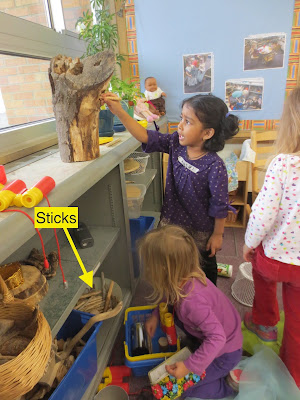The Life of a Dead Tree Trunk in the Classroom
Tom Bedard
Originally Posted in Sand and Water Tables, March, 22, 2021
Now retired, Tom Bedard, M.Ed. has worked in early childhood education since 1986. He has taught thousands of children representing diverse backgrounds and abilities, from infants to preschoolers. His particular interest has been to promote and analyze how children explore the area devoted to sensory play, to better understand their curiosity and competence in all areas of development. He has presented locally, nationally and internationally. Tom was the first early childhood teacher to be a finalist in the Minnesota Teacher of the Year program.
In a way, this post is a sequel to my previous post about the possibilities for play in a provocation I called the Swamp. The environment helped determine the possibilities. And by environment, I meant the process of setting up the provocation by me; I meant the children and the curiosity and imagination they brought to their investigations; and I meant the materials themselves, which begged to be explored.
This post is an experiment to see how the possibilities of play unfolded when just one of the materials offered to the children got placed in other parts of the room. The object and its potential I would like to examine is a piece of tree trunk from a tree I cut down in my yard.

As part of the swamp, the tree trunk was a loose part that could be used as a place where some of the plastic animals could find a home. (If you look closely in the picture above, there is a plastic grasshopper on the tree trunk.)
And because it was a loose part, it did not have to stay in the table. In the picture below, the child lifted the tree trunk out of the table and was about to drop it on the floor.

In a way, he was deconstructing the swamp by piling the pieces of wood on the floor. But at the same time, he was constructing his own collection of wood by using the floor as an open platform to pile.
After the swamp, I moved the tree trunk to the housekeeping area to see how the children would use it in their play and explorations. I placed it on the shelf by the window and by some living plants.

In the picture above, the child noticed that the tree trunk had a hole in it. She found a stick from the bowl of sticks on the bottom shelf and used it to explore the hole. By the way, the hole was an entrance to an old bird nest so it was worth exploring.
One child took the tree trunk off the shelf to put it on the floor where he proceeded to dislodge a piece that had rotted and become weak.

I noticed that the child found the work gloves in the house area to add a little authenticity to his deconstruction operation.
I subsequently moved the tree trunk to the writing table as a provocation with other Fall elements like gourds and corn. The children found many more ways to explore and examine this natural element.

For example, the child pictured below examined the bottom of the tree trunk. That way she was better able to see that the hole was bigger on the inside where the nest had been.

For another example, the child below found a different way to examine the hole in the tree trunk. He used one of the ears of the Fall corn to "measure" the size of the hole.

A good question is: Did any of the children draw the tree trunk? I do not know and since these pictures were taken more than five years ago, I do not even remember. However, one of the more stunning pictures I took was a picture of a child showing his mother the picture of the girl examining the bottom of the stump.

This was the same child who had used the Fall corn to explore the hole in the top of the tree trunk. In other words, the documentation from the week before triggered a memory, a memory that he could share with his mother about his own interaction with the tree trunk.
This was actually an enjoyable reflection for me. I remembered that I had brought a tree trunk into the room to add to the swamp, and I remembered that I had moved it around the room. However, I had not realized how this dried up piece of wood spawned so much engagement by the children in multiple areas of the room, whether that engagement was with the piece itself or in concert with other objects. The quintessential point was that this was a narrative about just one object in a sea of objects in my early childhood classroom. As it moved, so did the narrative. And it was not lost on me that this dried up piece of wood was basically waste wood not even good enough for firewood. Leave it to the children to bring it back to life and make multiple meanings out of it.